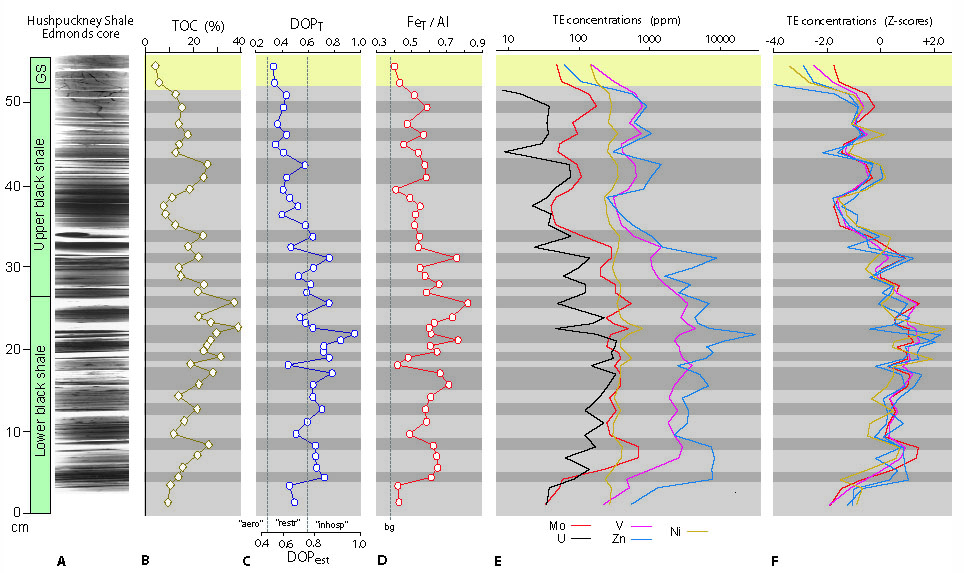RESEARCH
Thomas
J. Algeo
Professor
of Geology
University
of Cincinnati
Paleoceanography of
Epeiric Seas
|
I am interested in reconstructing the
physical and chemical conditions that existed in ancient epeiric seas.
The practical application of this work is in an improved understanding of
controls on the accumulation of organic-rich sediments that serve as
hydrocarbon source rocks. I use an integrated investigative
approach that includes analysis of:
-
major
and trace elements
-
TOC-TIC
-
Corg-N-S
isotopes
-
Mo-U
isotopes
-
biomarkers
-
petrographic
data
-
time
series analysis
(Figure at right from Algeo and Maynard,
2008)
|

|

|
My most comprehensive
analysis to date is of the Late Pennsylvanian Midcontinent Sea (LPMS) of North
America (right). This paleosea was interesting owing to widespread
development of anoxic facies despite absence of a bounding sill,
relatively shallow water depths, and modest levels of primary
productivity. The key
factor controlling benthic redox conditions appears to have been lateral advection of
“preconditioned” intermediate waters from Panthalassa. As in the modern
eastern tropical Pacific, the oxygen-minimum zone (OMZ) in the Late Pennsylvanian eastern tropical Panthalassic
Ocean may have risen to
depths of <100 m. Lateral advection of oxygen-depleted deep waters,
in combination with strong water-column stratification of the LPMS,
resulted in the widespread development of anoxic conditions across the
Midcontinent region during periods of glacio-eustatic highstand. The
details of LPMS paleoceanography are considered in Algeo et al. (2004),
Algeo and Heckel (2008), Algeo and Maynard (2008), Algeo et al. (2008a,b),
Algeo and Tribovillard (2009), and Herrmann et al. (2012). |
References
Algeo, T.J., and
Heckel, P.H., 2008, The Late Pennsylvanian Midcontinent Sea of North America: A
review. Palaeogeography Palaeoclimatology
Palaeoecology, v. 268, p. 205-221, doi:10.1016/j.palaeo.2008.03.049.
Algeo, T.J., and
Maynard, J.B., 2008, Trace metal covariation as a guide to water-mass conditions
in ancient anoxic marine environments. Geosphere.
v. 4; no. 5; p. 872-887; doi: 10.1130/GES00174.1.
Algeo, T.J., and
Tribovillard, N. 2009. Environmental analysis of paleoceanographic systems based
on molybdenum-uranium covariation. Chemical
Geology, v. 268, p. 211-225, doi:10.1016/j.chemgeo.2009.09.001.
Algeo,
T.J., Heckel, P.H., Maynard, J.B., Blakey, R., and Rowe, H., 2008. Modern and
ancient epicratonic seas and the superestuarine circulation model of marine
anoxia. In: Holmden, C., Pratt, B.R. (Eds.), Dynamics of
Epeiric
Seas
: Sedimentological, Paleontological and Geochemical Perspectives. Geological
Association of
Canada
Special Publication, v. 48, p. 7-38.
Algeo, T.J.,
Rowe, H., Hower, J.C., Schwark, L., Hermann, A., and Heckel, P.H., 2008, Oceanic
denitrification during Late Carboniferous glacial-interglacial cycles. Nature Geoscience, v. 1, p. 709-714, doi:10.1038/ngeo307.
Algeo, T.J.,
Schwark, L., and Hower, J.C., 2004, High-resolution geochemistry and sequence
stratigraphy of the Hushpuckney Shale (Swope Formation, eastern Kansas):
Implications for climato-environmental dynamics of the Late Pennsylvanian
Midcontinent Seaway. Chemical Geology, v. 206, p. 259-288.
doi:10.1016/j.chemgeo.2003.12.028.
Herrmann, A., Kendall, B., Algeo, T.J., Gordon, G.W.,
Wasylenski, L., Anbar, A.D., 2012. Anomalous molybdenum isotope trends in Upper
Pennsylvanian euxinic facies: Significance for use of d98Mo
as a global marine redox proxy. Chemical
Geology, in press. doi:10.1016/j.chemgeol.2012.05.013.
Last
updated 17 Sept 2012
Back
to Research Page
Back
to Homepage

